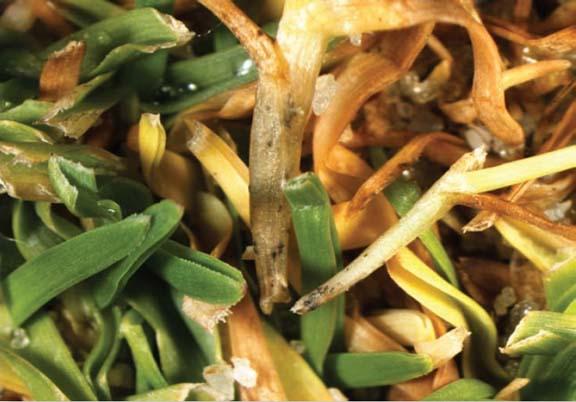Hot, humid conditions late into the summer provide an environment that is a simmering cauldron for anthracnose on annual bluegrass putting surfaces.
Rutgers University's best management practices for annual bluegrass putting greens provides information on fertilization, mowing and rolling, use of plant growth regulators, irrigation, topdressing, cultivation practices and fungicide use to help golf course superintendents manage anthracnose or avoid it entirely.
Fertilization
Nitrogen should be applied to maintain vigor without overfertilizing. Annual "summer" soluble nitrogen rates of 2.4 to 3.6 pounds of N per 1,000 square feet should be applied to reduced anthracnose incidence and severity. A rate at the higher end of the range will be needed if nitrogen rates have been historically low.
Beginning soluble nitrogen programs in April or May at 0.4 pounds to 0.8 pounds of nitrogen per 1,000 square feet per month can build up nitrogen in the turf heading into summer, which can result in decreased anthracnose severity.
Any granular nitrogen fertilization should be emphasized in the spring at rates of 1 pound to 3 pounds per 1,000 square feet to reduce disease severity. A rate at the high end of the range will be needed if nitrogen rates have been low historically.
Potassium should be applied to maintain moderate to high levels of soil potassium. Soluble potassium applications should be made at 1:1 or 2:1 N:K molar adjusted-ration every 14 days to reduce anthracnose severity.
Mowing and rolling
Mowing below 0.125 inches should be avoided when used fixed-head mowers - probably a slightly lower bench setting is OK for flex units. If possible, raise the cutting height as high as 0.140 inches for greater suppression of anthracnose. Slight increases in mowing height can significantly reduce the severity of this disease. Thus, use of solid rollers versus grooved rollers, at the same bench height setting, might also be helpful.
Roll and/or increase mowing frequency to maintain ball-roll distances at higher mowing heights. Rolling and double-cutting increase ball roll, but will not enhance disease severity.
Rolling every other day can result in slightly decreased anthracnose severity, regardless of roller type.
Test the rootzone annually to ensure that soil pH does not become too acidic.
If limestone is required, base the quantity to be applied on a target pH of 6.0 and the buffering capacity of the soil (lime requirement index).
Plant growth regulators
Routine trinexapac-ethyl use even at high rates and short intervals will not increase and might reduce anthracnose severity by improving turf tolerance to low mowing and enhancing plant health.
Mefluidide and ethephon can be used to suppress seedhead formation in annual bluegrass without increasing anthracnose.
Mefluidide or ethephon applied in March or April at label rates with subsequent applications of trinexapac-ethyl at 0.1 ouches to 0.2 ounces per 1,000 square feet every seven to 14 days will provide the best turf quality and might reduce anthracnose.
Irrigation
Increased anthracnose can result when annual bluegrass is consistently subjected to wilt stress or excessively wet conditions.
Irrigating to replace 60 percent to 80 percent of potential evapotranspiration and hand watering as needed to avoid wilt stress will provide a quality playing surface and reduce conditions favorable for anthracnose.
Topdressing
Bi-weekly sand topdressing in the "summer" with up to 100 pounds per 1,000 square feet provides a protective layer of sand around the crown, which slightly raises the effective
height of cut thus reducing anthracnose.
Topdressing in the spring at 400 pounds to 800 pounds per 1,000 square feet is more effective than fall applications in reducing anthracnose severity. These rates do not include the quantity of sand needed to fill coring holes; more sand will be needed if coring is done at the same time as topdressing. The amount of sand needed will depend on the diameter and spacing of coring holes.
Anthracnose does not appear to be affected by different sand incorporation techniques, so
methods which best incorporate sand should be selected to minimize turf injury and wear on
mowing equipment.
Foot traffic appears to reduce anthracnose, regardless of sand topdressing. The benefits of sand topdressing (better wear tolerance and decreased disease) are also seen in areas that receive daily foot traffic.
Cultivation
Do not avoid the use of verti-cutting or other cultivation practices if needed when disease is present, since wounding from these practices has not been shown to increase anthracnose severity. However, make sure fungicides have recently been applied before utilizing any cultivation practice when anthracnose is active.
Fungicide management
Avoid the sequential use of any fungicide chemistry and tank-mix or alternate fungicides with different modes of action to enhance efficacy and reduce the potential for resistant strains of the anthracnose pathogen from developing.
Develop fungicide programs that focus on the strengths (efficacy) of fungicide chemistries and time their application to optimize the control of all major diseases on the site.
Use as many different fungicide chemistries with proven efficacy against anthracnose - i.e., the QoI, DMI, Nitrile (chlorothalonil), benzimidazole, dicarboximide (iprodione), phosphonate, antibiotic (polyoxin-D), and phenylpyrrole fungicides - as practical during the growing season to enhance anthracnose control and reduce the potential for fungicide resistance.


